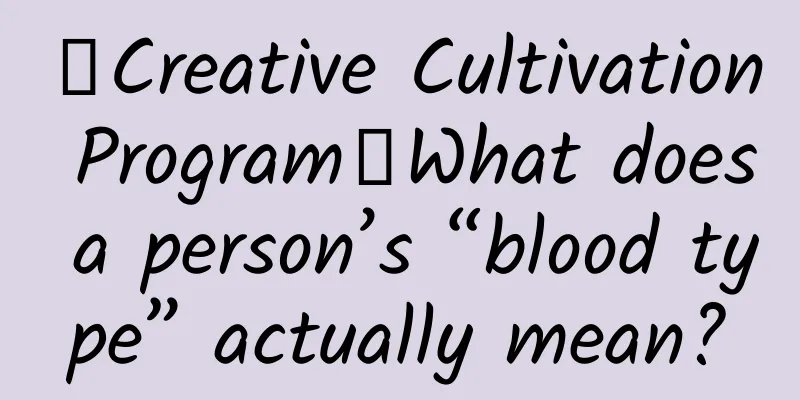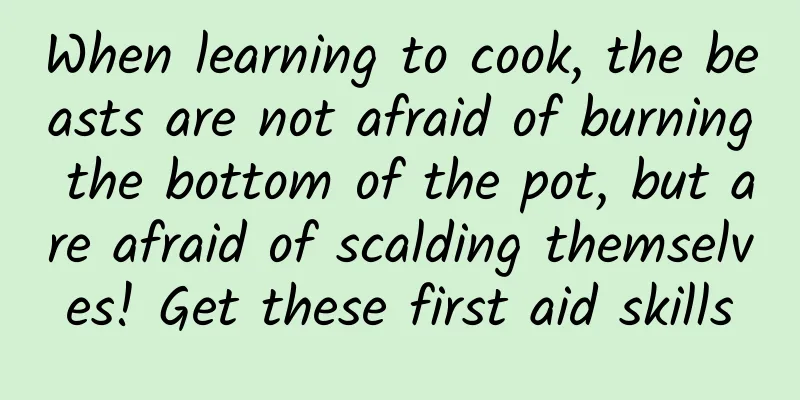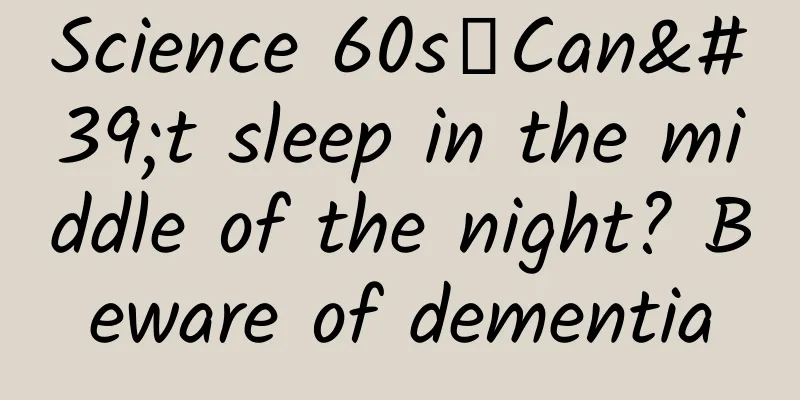【Creative Cultivation Program】What does a person’s “blood type” actually mean?

|
Author: Li Jinghui (PhD student in Medical Experimental Class, Tsinghua University) Reviewer: Wang Wei (Deputy Chief Physician, Shanghai Fifth People's Hospital, Fudan University) There are various sayings about blood types: people with type A blood are aggressive, people with type O blood attract mosquitoes, and people with type AB blood are prone to schizophrenia. Of course, none of these are reliable, but what exactly is blood type? What does it determine? Hello everyone, I am Li Jinghui. Today I will talk about blood types. In medicine, blood type actually refers to the blood type antigens on the surface of the red blood cell membrane. Our blood is composed of plasma and various blood cells, the largest of which are red blood cells. The rich hemoglobin in red blood cells is also the reason why the blood is bright red. Antigens refer to substances that can induce immune responses in our bodies. It is like an identity card that allows our immune system to identify ourselves and "foreign" molecules. When foreign antigens enter the human body, they activate T lymphocytes and B lymphocytes in the body. Activated T lymphocytes remember this antigen, and when they encounter cells expressing this antigen in the future, they will kill them without leaving a single piece of armor. Activated B lymphocytes can produce immune antibodies, which can specifically bind to antigens and undergo agglutination reactions, preventing antigens from passing freely in our bodies. There are many such antigens on the surface of our red blood cell membranes, which we call blood type antigens. Some of these antigens protrude from the surface of red blood cells, like branches extending from the ground, such as type A and type B antigens; some are embedded in the red blood cell membrane, such as Rh antigens. Contrary to what we thought, there are currently hundreds of known blood type antigens, which belong to 36 different blood type systems, the most important of which are the ABO blood type system and the Rh blood type system. The ABO blood type system, which is what we often say, includes the four common blood types A, B, AB and O. The naming of these blood types is based on the types of blood type antigens on the surface of red blood cells. Type A blood has type A antigens on the surface of red blood cells, type B blood has type B antigens, and type AB blood has both type A and type B antigens on the surface of red blood cells. What about those who have neither of these antigens? That's type O blood. We just mentioned that foreign antigens can stimulate B cells to produce immune antibodies, but in addition to this, our blood actually contains natural antibodies. People with type A blood naturally have anti-B antibodies in their plasma. When anti-B antibodies meet red blood cells expressing type B antigens, the two will undergo a specific agglutination reaction, causing the red blood cells to rupture, which is the so-called "hemolytic" reaction. People with type B blood have anti-A antibodies in their plasma. People with type AB blood have neither of these antibodies; people with type O blood have both antibodies in their plasma. In my country, type O blood accounts for about 40%, making it the most common blood type in China. The Rh system includes more than 50 red blood cell antigens, among which the D antigen is the most immunogenic, which means it can induce the strongest immune response in the body. Therefore, we call people with the D antigen Rh positive, and those without the D antigen Rh negative. Among Westerners, the proportion of Rh negative is about 15%, but among the Han population in my country, it only accounts for 0.3%. Rh negative blood type is very rare, so it is called "panda blood". It is worth mentioning that in addition to red blood cells, other blood cells also have antigens on their surfaces. For example, white blood cells have human leukocyte antigens (HLA) on their surfaces, and platelets have human platelet-specific antigens (HPA) on their surfaces. However, since red blood cells account for the vast majority of blood, the impact of white blood cell and platelet surface antigens on blood transfusions can generally be ignored. Speaking of blood transfusion, everyone must be familiar with it. Blood is more precious than gold, and we cannot live without it in our daily life. Red blood cells can transport oxygen and provide energy for tissues and organs; white blood cells can fight against the invasion of pathogens; and platelets can stop bleeding in time when we are injured. When the amount of blood loss reaches more than 20%, we will be in danger of life. Therefore, during major surgery or trauma, we need blood transfusions to maintain circulating blood volume. Patients with blood diseases have normal blood volume, but there will be a certain degree of lack of effective components in the blood. When the degree is more serious, blood transfusion is also necessary for them to maintain life. In blood transfusion, blood type compatibility is the most important principle. In the process of blood transfusion, the largest number of transfusions are red blood cells. If the antigens on the surface of the donor's red blood cells can specifically agglutinate with the antibodies in the recipient's plasma, hemolysis will occur, which can be life-threatening in severe cases. O-type red blood cells do not have A and B antigens and will not induce agglutination reactions, so they are called "universal blood donors." Does this mean that O-type blood can be transfused to people of any blood type? Don't forget that when we transfuse blood, in addition to red blood cells, we also transfuse donor plasma. O-type plasma contains anti-A and anti-B antibodies. If the recipient is not O-type blood, it means that their red blood cells contain A or B antigens on the surface, which may agglutinate with the antibodies in the donor plasma. Although the impact of donor plasma antibodies in blood transfusion is far less than that of donor red blood cell surface antigens, when the amount of blood transfusion is large, the impact of antibodies cannot be ignored. Therefore, unless it is absolutely necessary, we should adhere to the principle of blood transfusion with completely compatible blood types. So, as long as the blood types match, can we transfuse blood to each other? This is not the case. In movies and TV dramas, we often see such scenes - relatives are in danger and need emergency blood transfusions, and the protagonist immediately rolls up his sleeves and shouts: "Draw my blood!" But in fact, blood transfusions cannot be performed between direct relatives. This is because, in addition to red blood cells and plasma, there are also a small number of donor lymphocytes in the transfused blood. Under normal circumstances, the lymphocytes in the recipient's body can recognize foreign molecules based on the differences in HLA and eliminate foreign lymphocytes. However, the similarity of HLA between direct relatives is very high, which confuses the lymphocytes and makes them unable to eliminate these foreign molecules. As a result, the donor's lymphocytes can survive and proliferate in the recipient's body, and eventually become the host, launching a "rejection attack" on the recipient's own cells, thereby causing fatal graft-versus-host disease. In addition, the husband cannot give blood transfusion to his wife. Although there is no blood relationship between the husband and wife, after receiving the husband's blood, the wife will produce immune antibodies against the antigens on the surface of the husband's red blood cells. These antibodies will not have much impact on the wife, but when she becomes pregnant, the antibodies will pass through the placenta into the fetus. The fetus's red blood cell surface antigens are similar to those of the father, and under the action of antibodies, red blood cells will aggregate, causing fatal neonatal hemolytic disease. So, at this point, everyone probably has a certain understanding of blood type, that is, blood type is the blood type antigen on the surface of red blood cells, which determines the "identity" of our red blood cells. As for whether your personality is radical, whether you attract mosquitoes, or whether you are more susceptible to certain diseases, these are not determined by blood type. (The article is produced by Science Popularization China-Creation Cultivation Program. Please indicate the source when reprinting) |
<<: The hairy crab waits two years for its once-in-a-lifetime mating opportunity, and then…
>>: The saltiest sea in the world, would you like to have a taste?
Recommend
iOS apps are banned from being "free" and Apple did not explain why
Now, if the word "free" appears in the n...
What are the methods for app promotion? Share 5 tips!
As the most important distribution channel for Ap...
Is it true that people have no memory before the age of 3? Why is this so?
I have talked about people’s childhood memory pro...
Fever myths: How high a fever can damage the brain? The truth is…
You must have heard others say A child's feve...
Your blood vessels are quietly developing plaques and hardening! Do this and the "plaques" may shrink or even disappear
This article was reviewed by Fang Jie, Associate ...
The latest picture of Yutu-2 is released! Sending you New Year's greetings!
"Yutu" is here to wish you a happy new ...
What exactly does the “zero additives” on food packaging mean?
On March 27, 2023, the new version of food safety...
Tips for placing ads on TikTok’s information feed!
How to attract consumers’ attention within three ...
"Operational methods in the post-product era" How to do content operation well?
Let’s first define content operations : Everythin...
How to achieve growth at low prices? Let you know Xiaomi's business model
How to achieve growth at low prices? How to make ...
Introducing 5 data-driven and practical customer acquisition methods
Admittedly, in many cases, the acquisition of new...
A Complete Guide to Business Analysis - Using Data Analysis to Solve Business Problems
A Complete Guide to Business Analysis - Using Dat...









